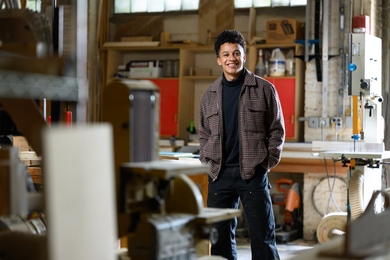In Erin Lavik's nine years as a student in the Department of Materials Science and Engineering, she's earned an SB (1995), an SM (1997) and is currently working on her PhD. She's also honed her skills as a playwright.
Her first play was produced as part of the Dramashop fall one-acts last year and now she's polishing her first full-length play, The Inheritance , for its world premiere September 16-18 at 8pm in Kresge Rehearsal Room B (call x5-8637 for more information).
The play, about a young woman who inherits a nursing chair at her uncle's funeral, depicts how the woman and her mother become connected to themselves and their past, while learning about the forebears who previously owned the chair.
Ranking The Inheritance as one of her "most challenging and satisfying experiences," director Ronni Marshak said, "Working with a playwright on a new work can be very difficult, but Erin and I have worked very well to continuously allow the script to grow and mature."
"Erin shows an understanding of family relationships well beyond her years," Ms. Marshak added. "The language is natural, yet with a haunting poetry, especially in the more emotional scenes. And it's surprisingly funny."
The director also praised the cast composed of MIT alumni/ae, students and affiliates. "The quality of acting is amazing. The actors... are always exploring, suggesting and learning."
Lynn Heinemann of the Office of the Arts asked Ms. Lavik about her creative endeavor.
Is the story at all autobiographical?
I did inherit a nursing chair from my mother's family and it did get me thinking about what my relatives might have been like. I wrote the play to honor their memories, but the characters within the play are fictional.
What is a nursing chair?
I get asked this a lot and I wouldn't have known had I not inherited one. It's a chair built to make nursing an infant easier.
How long did it take to write?
I started writing The Inheritance last fall as part of an independent study with [playwright and lecturer in music and theater arts] Laura Harrington. Technically, it was part of my minor for my graduate program, but in truth, it was and is a labor of love.
How did you first develop an interest in theater?
I was part of Next Act [shows put on at Next House] for my four years as an undergrad. Next Act embodies all the things I love about theater. People who've never done theater before throw themselves into the productions and create performances that are always sincere, enthusiastic and generous. The annual event is one of unbounded joy for all those who have ever participated.
I had never really done any theater before. In high school, I tried out for Twelfth Night and was asked to seriously consider looking into the sports program.
What playwrights do you most admire?
I don't know that I have playwrights I admire so much as I have plays I adore. I am particularly fond of Three Tall Women by Albee, Love Letters by Gurney and Arcadia by Stoppard. Each of these plays uses simple means to create extraordinary magic. I would consider myself blessed to write something that could stand in their shadows.
How did The Inheritance come to production?
I invited Ann-Marie White [a biology graduate student and member of Shakespeare Ensemble] to the initial reading of the play, which was part of Laura Harrington's playwriting class last December. Ann-Marie said that she really connected with it and would like to see it produced. [Ms. White received a grant from the Council for the Arts at MIT to produce the show.]
How long have rehearsals been running?
We held auditions in late June and began rehearsing in July, but did not begin regular rehearsals until August. Since then, we've been rehearsing three to four nights a week.
How active have you been through the production phase?
I've been rewriting and revising the play throughout the production process, and working to help clarify context and meaning and rewrite sections when necessary. I've also pulled set pieces, costumes, obtained rehearsal spaces and generally tried to make sure this production will work. We shall see what happens in performance.
A version of this article appeared in the September 15, 1999 issue of MIT Tech Talk (Volume 44, Number 5).





